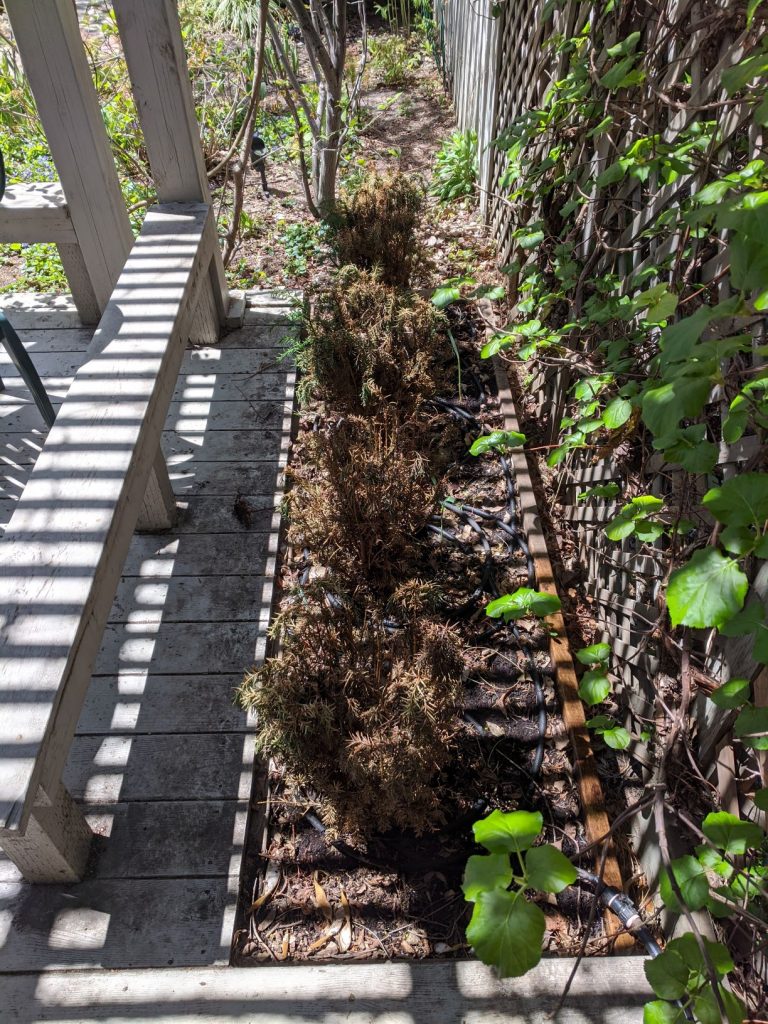
Hi, Last 2 years we’ve tried to plant yews beside our back deck, it’s very shady and doesn’t get tons of water, we have a rain barrel and a soaker hose. Both winters they’ve died. We’d like to plant something hardy there, a perennial that might grow 4-5 feet or so at least. Any suggestions?
Thanks for your help,
Jim Crummey.
Thank you for contacting the Toronto Master Gardeners.
We receive numerous questions concerning planting in dry shade. If you type “dry shade” into the search bar located to the right of the page you will see a number of archived posts.
The following information if from two of our earlier posts:
“The bane of the shade garden and shade gardener is dry shade, usually caused by competition from nearby trees. The fine roots of your established oak tree compete for the moisture and nutrients in the soil at the expense of newly planted plants. Before planting, loosen the existing top soil with a garden fork and add a layer of compost, thereby increasing the soil’s water retention. Be careful not to raise the grade above the tree roots more than 10cm, this may compromise the health of your tree. Every fall I would continue to improve the texture and quality of the soil by loosening the topsoil and adding in at least 15cm of shredded leaves along with 2.5cm of compost.
Here is a list of some evergreens for you to consider:
Hinoki Cypress (Chamaecyparis obtusa ‘Nana Gracilis’): this evergreen grows in full sun to part shade. This is a slow growing conical evergreen which will reach 6-9′ at maturity.
Yews (Taxus spp.) Yews come in many sizes and shapes. Unlike cedars which do best in full sun and moist soil, once established yews can handle partial shade and some varieties such as Upright Japanese Yew (T. cuspidata ‘Morden Upright’), Dwarf Japanese Yew (Taxus cuspidata ‘Nana’) , Globe Japanese Yew (Taxus cuspidata ‘Clipped Globe’) and Taxus x media ‘Runyan’ can grow in full shade. The above yews come in many shapes: pyramidal shapes, columnar shape, global and spreading and sizes Before you make your choice make sure to check the mature height and spread.
Jeddeloh Dwarf Hemlock (Tsuga canadensis ‘Jeddeloh’): Grows best in medium moisture, well-drained soils in part shade to full shade. This plant grows as a dwarf, flat-topped, spreading mound with a distinctive funnelform center depression that resembles a bird’s nest. mature height is 2-3′ and 3-4′ wide.
Dogwood (Cornus spp.) Cornus is a genus of about 30–60 species of woody plants which grow in full sun to part shade and are tolerant of a wide range of soil conditions. Their colourful branches add winter interest to the landscape.
Japanese Pieris (Pieris sp.): These shrubs grow and flower best when planted in full sun or partial shade. They will grow in deep shade, but generally do not flower as well, and the new foliage growth is usually not as brilliant.
Oregon Grape (Mahonia aquifolium): Is a broadleaf evergreen shrub with shiny holly-like leaflets
Dwarf Highbush Cranberry (Viburnum trilobum ‘Compactum’): is a rounded shrub with dark green foliage which turns red in the fall along with red berries in October. Does best in full sun to part shade.
Common Snowberry (Symphoricarpos albus) Grow in average, medium moisture, well-drained soils in full sun to part shade. Best fruit production occurs in full sun.
This link lists additional drought-tolerant shrubs for shade
Some perennials to consider planting are: Barrenwort (Epimedium spp.), Wild ginger (Asarum canadense) is a great native ground cover, Lenten Rose (Helleborus spp.), Siberian bugloss (Brunnera sp.). Garden Making has an excellent article on Planting in Dry and Shady Gardens There are also a number of native perennials that can tolerate or even thrive in dry shade.This link provides quite a comprehensive list.
Lastly, the Toronto Master Gardeners have a number of Gardening Guides which you might find useful: Perennials for Shade in Dry or Moist Area ,and Ornamental Shrubs for Various Light Conditions”
“Sandy soils drain quickly so are usually dry and also are poor in nutrients. Most plants for sandy soils require full or at least part sun and the selection of plants for shade and sandy soils are very limited. It would be helpful to amend the soil you have with about 10 – 15cm of organic material such as compost once each year. This would help increase the amount of nutrients to feed your new shrubs, improve the soil structure so your plants grow better and increase it’s moisture holding capacity so a wider variety of plants might survive in your gardens. Usually it is advisable just to put the compost on top of the soil as digging it in will destroy the beneficial fungi that have managed to grow underneath the surface. I would definitely dig in compost when you are planting the shrubs however as you have to dig a hole anyway for the plant. Some shade tolerant well draining soil shrubs with mostly white flowers are:
Hamamelis virginiana (yellow flowers), Aronia melanocarpa, Stephanandra incisa, Symphocarpos albus and Symphocarpos orbiculatus. Some shrubs that prefer more part shade with white flowers and would greatly benefit from some compost soil amendment and a bit more watering would be: Cornus rugosa, Cornus drummondii, Cornus racemosa, Viburnum acerifolium, Viburnum trilobum, Amelanchier laevis and Clethra alnifolia.
It might also be helpful to have some tall white flowering perennials for dry shade: Actaea racemosa, Aruncus dioicus and Dicentra spectabilis.”
Happy Planting!

